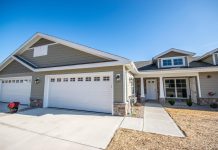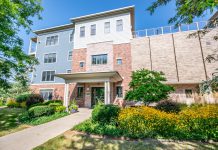August 28, 2019 – St. John’s Evangelical Lutheran Church in Newburg is prepping to celebrate its 160th anniversary. The mission festival will be Sunday, Sept. 8. Leading up to the celebration there’s a story series being rolled out regarding the history of the parish.
Click HERE to read more about the history of St. John’s Evangelical Lutheran Church in Newburg
THE DEVELOPMENT PASTOR G. VORBERG, 1863-1865
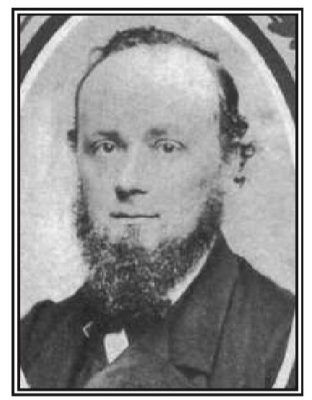
Not long after Pastor Roell’s departure, God provided this congregation with a faithful servant in the person of Pastor G. Vorberg, who was installed December 22, 1863. Pastor Vorberg introduced the system of keeping records of all official acts, such as baptisms, confirmation, communion, marriages, and burials. Heal so made a record of all such acts which had taken place prior to that date, and of which no entry had been made.
Since his tenure, minutes are also kept of all meetings. In a meeting on February 1, 1864, he proposed a new constitution, which was accepted, and the old one was burned. At one time trouble seemed to have arisen because some members neglected to pay the sums they had pledged for the liquidation of the congregation’s debts. Stringent resolutions were passed, but it seems the matter was finally satisfactorily settled. During his pastorate here at St. John’s, Northwestern College in Watertown was established in 1865.
Later in 1866, he along with Gausewitz, Mayeroff, and others, were elected to the first Board of Trustees, then called Northwestern University. After two years of service here, Pastor Vorberg received a call from St. Matthew’s congregation of Milwaukee. St. John’s congregation was loath to let him go. Before Pastor Vorberg left, he recommended Pastor C. Gausewitz of Port Washington, who was called in a meeting of November 13, 1865.
PASTOR CARL GAUSEWITZ, 1865-1872

Pastor Gausewitz entered his new field of duties the last Thursday of the year 1865. During his pastorate of six years only the regular routine business occupied the meetings. It should be noted that Gausewitz was a confessional Lutheran and a close friend of Johann Bading, president of the Wisconsin Synod.
Gausewitz was one of the representatives at the colloquy between the Missouri and Wisconsin synods on October 22, 1868. It was here that the two synods achieved complete agreement in doctrine and practice. Pastor Gausewitz was called by the Zum Kripplein Christi Church in the Town of Herman, Dodge County, Wisconsin.
PASTOR ERNST MAYERHOFF, 1872-1883
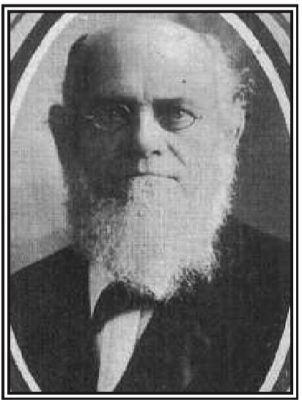
Before Pastor Gausewitz left, he installed his successor, Pastor Ernst Mayerhoff, on the 11th Sunday after Trinity, 1872. In 1874, the congregation bought a bell from the John Stuckstede & Bro. Foundry of St.Louis, MO., at the cost of $320.90.
Jacob Bloecher is mentioned as being especially instrumental in securing the bell. The bell was received for installation in the week of December 14, 1874. Five years later it cracked and was sent back to the foundry to be recast.
On a bill of August 18,1880, we find that to 641½ pounds of old metal, 51½ pounds of new metal were added, giving the bell proper a total weight of 693 pounds. The cost of recasting was $38.53, which was paid by the Frauenverein (Ladies’ Society).
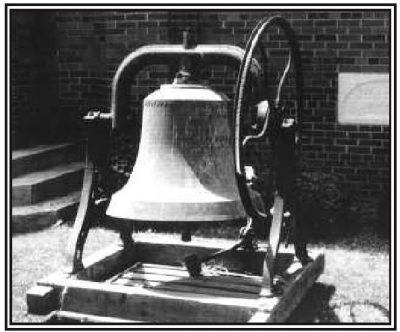
This same bell was placed in the second church tower in 1926, and in the third church tower in 2001. It has served the congregation for 129 years. In a meeting of February 17, 1882, Traugott Seidemann reported the purchase of about one acre of land lying northwest of the church property and adjacent to it, for the sum of $125.00.
This land was bought for a private cemetery of the congregation. In regard to the method of burial, it was decided that the graves should be made in rows in the order in which the deaths occur.
Married people were permitted to reserve a burial place beside their deceased spouse. The cemetery was fenced in at a cost of $31.83. In the following year, 1883, an organ was bought. The cost of the organ, together with the Choralbuch and book of interludes, was $118.06. Mrs. D. Poggenburg practiced the melodies of our beautiful church hymns according to the Choralbuch with a number of older and younger people and succeeded in improving the singing of the congregation.
PASTOR EDUARD HOYER, 1883-1904
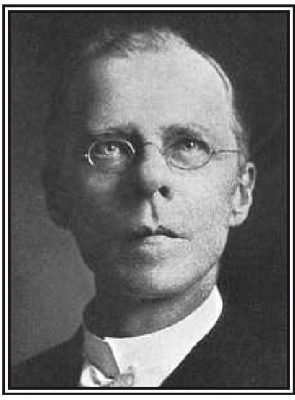
In the fall of the year 1883, Pastor Mayerhoff received a call to Forest, near Fond du Lac, Wisconsin. He was succeeded by Pastor Eduard Hoyer, who had been pastor of St.Paul’s congregation in Platteville,Wisconsin, for five years.
He was installed by his predecessor on the 24th Sunday after Trinity, 1883. Until now, confirmation classes had been conducted in the church, except during two winters, when Herman Koenig and Dietrich Poggenburg had offered their homes for this purpose. In 1884 a schoolhouse was erected at a cost of $219.88 for confirmation instruction and Sunday School.
The building was completed by fall. The building committee in charge was: D. Poggenburg, Jacob Bloecher, and Joh. Beimborn.
The following three years, school was taught in July and August in the German language by students from our colleges. In the meeting of January 11, 1887, Pastor Hoyer reminded the congregation that on August 13, it would be 25 years since their church was dedicated, where upon the congregation decided to celebrate the occasion.
Numerous improvements were also decided upon. The roof was re-shingled, the tower point was redecorated with a double cross, the walls were whitewashed, the woodwork was painted and varnished, and new windows were provided.
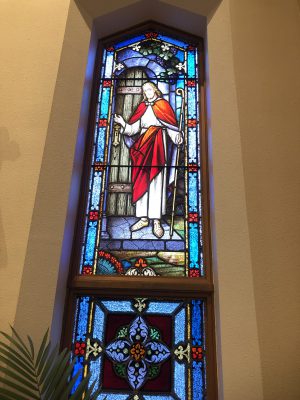
A committee of three, Herman Koenig, Christian Kelk, and Johann Rau, was entrusted with this work, which was done in a most satisfactory manner.
In addition, two candlesticks and a flag on for communion were purchased. The money for these latter items, as well as for the ornament for the tower, was solicited by the Misses Rosa Schmidt, Emma Plenzke, and Marie Erler from the women and young people of the congregation.
They collected a sum of $54.00. Pastor C. Gausewitz preached in the forenoon, and Pastor E. Mayerhoff in the afternoon. Student Plocher of Watertown taught school in July and August. Through his efforts a choir was organized which sang for the Jubilee. The West Bend choir under the direction of Teacher Schneider assisted. In the year 1894, Mrs. William Plenzke and Miss Helen Thode presented the congregation with a black altar hanging and pulpit antependia for use during the Lenten season.
Since 1895, a summer school was conducted from April to June.
No names of teachers are recorded, except that of Miss Elsa Hoyer, who was engaged in 1899, had taught for several years. In 1896, a new organ was bought, and an entrance hall built on to the church.
In 1899, it was voted to build an altar niche with a sacristy on the south end of the church. The committee members entrusted with this work were John R. Laubenstein, Gottfried Zinke, Henry Schmidt, Gustav Koenig, and William A. Plenzke. A blueprint from this project is in the church archives.
At a special meeting on June 11, 1899, it was resolved not to carry out this plan because the church was too old. Rather, a new church should be built and the same committee would serve. In January of 1900, this idea was voted down. Two were in favor and 20 were against it. At the May 6 meeting, it was voted to make necessary improvements in the church.

A new floor was laid, a new vestry, altar, and pulpit were built, and 23 new pews were purchased from the Manitowoc
Seating Works, Manitowoc, Wisconsin for $166.40.
Due to these changes, the interior of the church presented an entirely new appearance. Later in 1902, the roof of the church was renewed. The entire cost of the renovation amounted to $600, including an Altar Bible.
Pastor Hoyer organized the St. Johannes Frauenverein (Ladies’ Society) in 1899. Before this time, it was a group of women who would get together for fellowship and the good of the congregation. In the archives there are German minutes from 1899-1915 for the Frauenverein. In the meeting of January, 1904, a committee, consisting of John R. Laubenstein, William Plenzke, and Fred Erler, was appointed to canvass the congregation in order to find out whether the members were willing to raise their dues so that a yearly salary of $500 would be assured. In March, the committee reported that the required amount for the salary had been pledged, whereupon Pastor Hoyer declared the congregation to be self-supporting and resigned as its pastor.
The congregation immediately proceeded to call it sown pastor. The call was sent to the Candidate of Theology, William C. Mahnke, a graduate of our Theological Seminary of Wauwatosa, Wisconsin, who accepted the call. Pastor Hoyer recommended several paragraphs to be added to the constitution, relating to the school admittance of new members, announcements for communion, and meeting of the church council, all of which were accepted by the congregation.
During the summer of this year, the congregation purchased the lot and dwelling house lying southeast of the church property and adjacent to it, for the sum of $850, to be used for a parsonage. Pastor Hoyer served this congregation 21 years.
For more on the history of St. John’s Evangelical Lutheran Church in Newburg click HERE.




